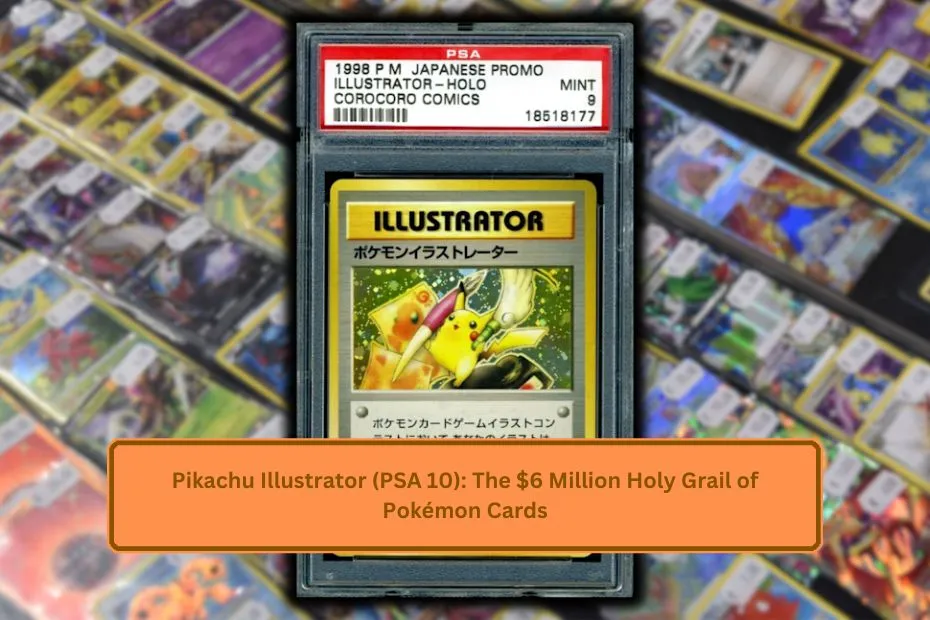Pokémon cards have evolved from a childhood hobby to a booming collectors’ market, where certain rare cards now sell for thousands — sometimes even hundreds of thousands — of dollars. While you might think these valuable gems are only found in sealed vaults, some could be sitting in your attic or an old shoebox. This article uncovers 10 Pokémon cards worth over $5,000 that you might actually own, along with detailed insights into their history, value factors, and how to spot authentic versions.
1. 1st Edition Charizard Holo (Base Set, 1999)
This card is the holy grail of Pokémon collecting. The 1st Edition Charizard Holo from the Base Set features a fiery design by Mitsuhiro Arita and is revered for its nostalgia and rarity.
- Why It’s Valuable: The 1st edition stamp, shadowless border, and holographic finish make it extremely desirable.
- Current Market Value: $15,000–$50,000+ (PSA 9 or 10)
- Check If You Own One: Look for the “1st Edition” stamp on the left and the absence of a shadow around the image box.
2. Pikachu Illustrator (1998)
Only 39 copies of this card were awarded to winners of an illustration contest in Japan. It’s often dubbed the “Mona Lisa” of Pokémon cards.
Why It’s Valuable: Rarity (less than 20 believed to still exist), historical importance, and elite exclusivity.
Current Market Value: $100,000–$5 million+
Check If You Own One: Features Pikachu holding art tools and Japanese promo text with a gold trophy logo.
3. 2005 EX Deoxys Gold Star Rayquaza
Gold Star cards showcase shiny Pokémon and were extremely limited in packs, often appearing just once every 2 boxes.
- Why It’s Valuable: One of the most iconic shiny Pokémon with ultra-low pull rates.
- Current Market Value: $6,000–$25,000 (PSA 10)
- Check If You Own One: Shiny Rayquaza in a black, serpentine form with a gold star next to its name.
4. 1999 Shadowless Blastoise Holo (Base Set)
This version of Blastoise, without the 1st edition stamp but also without a shadow, is part of the earliest Base Set print run.
Why It’s Valuable: Early print with nostalgic appeal and collector demand.
Current Market Value: $5,000–$12,000+
Check If You Own One: No 1st Edition stamp, but no shadow along the image box either.
5. 2000 Lugia 1st Edition (Neo Genesis)
Lugia was the face of the second Pokémon generation and received a legendary card in the Neo Genesis set.
Why It’s Valuable: High nostalgia, low PSA 10 population due to print quality.
Current Market Value: $6,000–$35,000+
Check If You Own One: Look for a 1st Edition stamp and the set symbol resembling a swirled leaf.
6. Tropical Wind (1999–2009, Various World Championships)
Tropical Wind was awarded exclusively to participants in early Pokémon World Championships, making each print rare and highly collectible.
- Why It’s Valuable: Limited distribution and strong player heritage.
- Current Market Value: $5,000–$50,000 depending on the year and condition.
- Check If You Own One: Unique art with Exeggutor or Psyduck lounging on a beach, plus year-stamped World Championship logos.
7. Shining Charizard (Neo Destiny, 2002)
This card was the first time a shiny Charizard was depicted on a Pokémon card. It marked the beginning of shiny card popularity.
Why It’s Valuable: First shiny Charizard ever, limited Neo Destiny print run.
Current Market Value: $5,000–$20,000 (PSA 9 or 10)
Check If You Own One: Look for white Charizard art and a shining star symbol.
8. Espeon Gold Star (POP Series 5)
POP Series cards were distributed through Pokémon leagues and events, not in regular booster packs. Espeon Gold Star is extremely rare.
Why It’s Valuable: Low population, difficult to pull or acquire.
Current Market Value: $10,000–$25,000+
Check If You Own One: Features shiny green Espeon with a gold star and minimalistic card background.
9. No. 1 Trainer Cards (Various Years)
Awarded only to top-ranked players at official Pokémon tournaments, each version is essentially a one-of-a-kind prize.
Why It’s Valuable: Only one or a few given out per event year.
Current Market Value: $15,000–$100,000+
Check If You Own One: Text reading “No. 1 Trainer” with elaborate Japanese or English tournament-themed designs.
10. Kangaskhan Family Event Trophy Card (1998)This rare promo was awarded to parent-child duos at a special event in Japan. Few exist in mint condition.
Why It’s Valuable: Extremely limited run and unique origin story.
Current Market Value: $10,000–$150,000+
Check If You Own One: Features Kangaskhan in a playful pose with the Japanese logo and a glossy finish.
Summary of High-Value Pokémon Cards
| Card Name | Year | Estimated Value | Unique Feature |
|---|---|---|---|
| 1st Edition Charizard Holo | 1999 | $15,000–$50,000+ | 1st edition, no shadow |
| Pikachu Illustrator | 1998 | $100K–$5 million | Trophy card with art theme |
| Gold Star Rayquaza | 2005 | $6,000–$25,000 | Shiny version with gold star |
| Shadowless Blastoise Holo | 1999 | $5,000–$12,000 | No shadow, early print |
| 1st Edition Lugia (Neo Genesis) | 2000 | $6,000–$35,000 | Popular Gen II Legendary |
| Tropical Wind | 1999–2009 | $5,000–$50,000 | World Championship exclusives |
| Shining Charizard | 2002 | $5,000–$20,000 | First shiny Charizard card |
| Espeon Gold Star (POP Series) | 2007 | $10,000–$25,000+ | POP League exclusive |
| No. 1 Trainer Cards | Varies | $15,000–$100,000+ | Tournament trophy only |
| Kangaskhan Family Trophy | 1998 | $10,000–$150,000+ | Parent-child Japanese promo |
Final Thoughts
The Pokémon trading card game isn’t just a game anymore — it’s a booming collector’s market where a single card can change your fortune. Whether you were a ’90s kid with a binder full of cards or a casual collector, now’s the perfect time to dust off your collection and take a closer look. One of these 10 Pokémon cards worth over $5,000 could be hiding in plain sight — and that treasure might just be yours.


